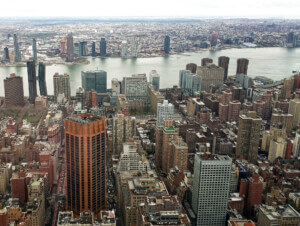Manhattan Borough President Gale Brewer and Councilperson Margaret Chin are pushing the Department of City Planning (DCP) to conduct additional reviews of three waterfront towers in the Two Bridges neighborhood. The pair said they will pursue legal action against the city if it doesn’t stop the developments.
Developers have set their sights on the Chinatown-adjacent area in recent years with a series of high-rise residential buildings. The 77-, 69-, and 62-story towers would sit less than a block away from the FDR Drive, near the Manhattan and Brooklyn bridges from which Two Bridges gets its names. JDS Development Group, the same firm behind the troubled supertall on Central Park, is backing the 77-story, SHoP-designed skyscraper at 247 Cherry Street, which will rise next to an under-construction 80-story tower, Extell’s One Manhattan Square, designed by Adamson Associates Architects. Two Bridges Associates is planning a double tower (69 stories each) with a shared platform at 260 South Street, and Starrett Development wants to build its 62-story structure at 259 Clinton Street.
Last year, Brewer and Chin, whose district includes the proposed towers, asked DCP to assess the development via a Uniform Land Use Review Procedure (ULURP), a seven-month review that goes through the community board all the way up to the mayor for public comment, revision, and further assessment before the development is approved or denied. Here, though, current zoning allows the towers to be built as-of-right, so no scrutiny through ULURP was legally necessary. The developers of the tower trio are only required to do environmental review for their project, though they did hold voluntary community reviews (which were interrupted by protests).
In response to community concerns, DCP is considering the projects together, instead of individually.
“While the modifications sought for the Two Bridges sites do not trigger ULURP—in other words no new density or waivers are needed—a thorough environmental review which offers multiple opportunities for the public and elected officials to participate is being conducted,” said DCP spokesperson Rachaele Raynoff, in an email to DNAinfo. “Moreover we are ensuring a coordinated review by the project applicants that looks at the cumulative effects of these three developments at the same time—an extraordinary but important measure that is not ordinarily required. This coordinated review will help produce the best possible outcome for this neighborhood. Much as we appreciate the desire of the community to do so, there are no grounds under which a ULURP could legally be required in this instance.”
Though there are many neighborhood groups across the city saying “no” to tall buildings, the political geography of downtown Manhattan lends the Two Bridges controversy a special edge. Restrictive zoning and landmarking shields wealthier and whiter neighborhoods downtown from skyscrapers, but those protections are missing in the Lower East Side or Chinatown, a condition that jeopardizes affordability and encourages what some see as out-of-scale development. Though activists are working to mitigate displacement, since 2002, Chinatown has lost more than 25 percent of its rent-regulated apartments. Now, neighbors are worried the developments will stress already over-burdened infrastructure, block natural light, and engender displacement in the low-income neighborhood by causing property values to spike. At One Manhattan Square, for example, prices for two-bedrooms start at almost $2.1 million.










